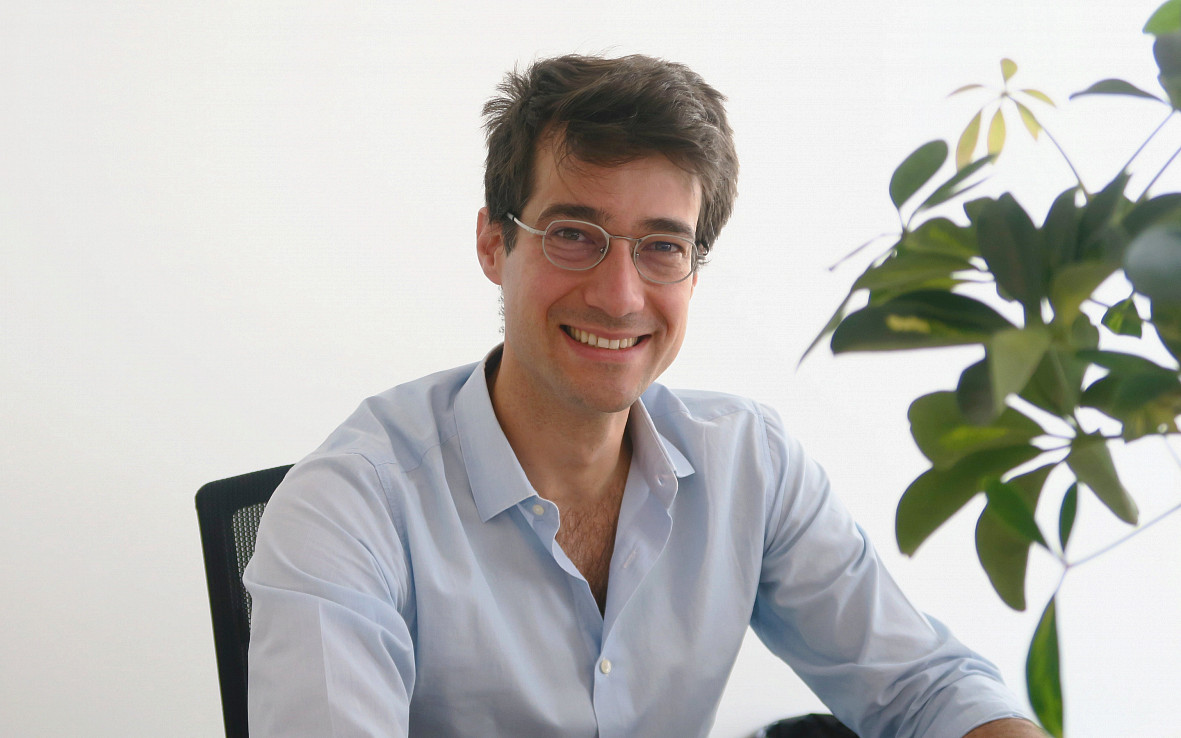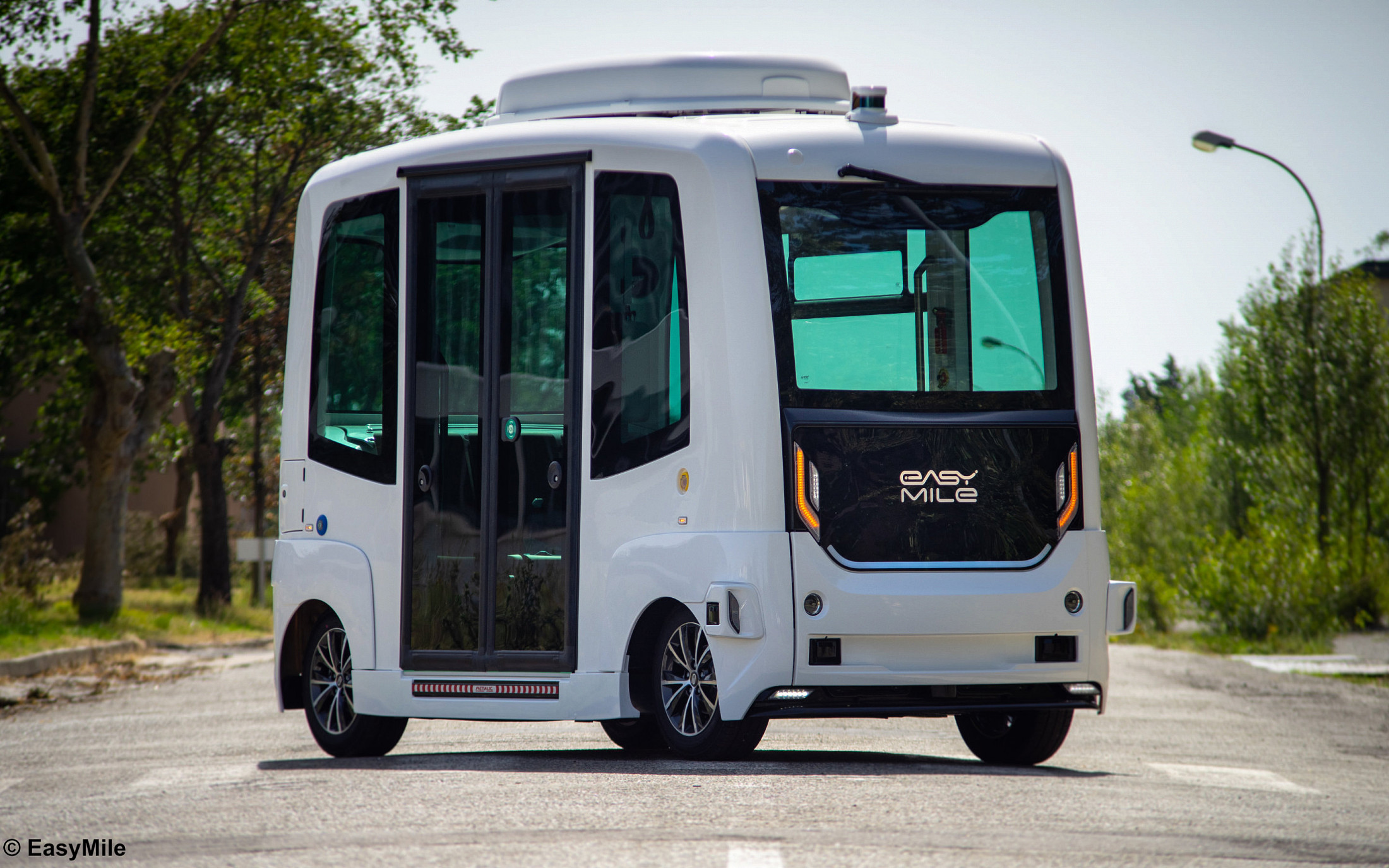Back in January we announced our cooperation with EasyMile at both CES and in an accompanying press release. You’re probably wondering what’s been going on since then and how the cooperation is progressing. That’s why Julius sat down for a catch up with Olivier, product and marketing director at Easy Mile, and Georg, product manager for solar integration at Sono Motors. Through their exchange he sought to discover what joint goals EasyMile and Sono are pursuing and what advantages solar integration in autonomous vehicles holds for the future.
Julius: Hi both, would you be able to introduce yourselves quickly?
Georg: Hi, I’m Georg and I’ve been working at Sono Motors for 1 ½ years now. When I started, I worked directly on the solar integration of the Sion and for the last 6 months I’ve been working as product manager for solar integration.
We would like our solar technology to not only be integrated in the Sion, but also onto other vehicles like EasyMile’s EZ10, for example. My job is, namely, to investigate how we can expand our product portfolio, how we want to further develop our technologies and also what other applications could come into question.

Olivier: Hi, I’m Oliver. I’m product and marketing director at EasyMile. I look after the market, pricing, and define the road map for the EZ10 shuttle. I am also in charge of selecting our cooperation partners.

Julius: How cool! How long have you been working at EasyMile for?
Olivier: I’ve been here for 3 years.
Julius: That’s quite a good amount of time. When was EasyMile founded?
Olivier: In 2014 actually. When I started in 2018 we were around 90 in the team but since then we’ve grown to 250. I’m an old hand here really.
Julius: You’re constantly growing there. How did the cooperation with Sono come about?
Olivier: Benedikt Sperling, our managing director for the DACH region, had contact with a colleague of yours and they discussed respective projects and technology. It then gradually became apparent that there are some really promising interfaces.
Georg: Yes – that was Lars who works in business development. A perfect match really as the EasyMile and Sono Motors visions align really well with one another.
Julius: Not all of our supporters are familiar with EasyMiles’ products. So, a quick question to kick things off – What exactly is the EZ10 shuttle?
Olivier: The EZ10 fully electric people mover solution supplements local public transport or relieves traffic congestion on factory or private premises, such as business parks – the use cases are virtually limitless. The driverless service enables us to almost completely close gaps on the so-called ‘first and last’ miles. The shuttle’s hardware is manufactured by French car manufacturer Ligier. We are mainly responsible for the intelligent software, which, by the way, can be installed on a number of other vehicle platforms.
Julius: Why are EZ10 shuttles the ideal platform for our solar integration? Do you see any particular advantages?
Olivier: There are many reasons why our shuttles are perfect for this. First of all, the whole basic principle of shared mobility is to get around in an efficient and environmentally friendly way. Fossil fuels are finite, so our entire product portfolio is all-electric. On the one hand for the sake of the environment, on the other fuels are a huge cost driver for public transport or in the logistics sector, where our other vehicle solutions are used. Our shuttles correspond to a clear vision of city life of the future: more efficient traffic, fewer vehicle noise disturbance, fewer private vehicles or parking spaces and therefore more space and quality of life.
Renewable energy is the optimal supplement here. Solar panels enable range extension and operating time in the most ecologically sustainable way possible. You are simply less dependent on the existing charging infrastructure and can also extend the time between charges. As a manufacturer of autonomous driving shuttles, this is a huge step forward for us. The fewer stops that have to be made whilst driving means that we can offer our customer both better service and more convincing prices and efficiency.
Julius: Absolutely, that sounds completely logical. Let’s talk about concrete numbers for a moment if we may. Georg, could you give us a rough idea of how much power an EZ10 shuttle with Sono Motors solar integration could generate over a day?
Georg: That’s a great question. The available space on the EZ10 shuttle’s roof and sides would be a great place for us, I think, to install panels with an output of around 1-1.5 kW. The rule of thumb dictates we would generate an estimated 3 - 5 kWh of energy per day. These are, of course, only rough estimates. The aim of a cooperation and especially of the prototype phase is to show how high the energy turnover is in reality. Throughout our cooperation, we will carefully examine and evaluate where our technology could be integrated on the vehicle. All in all, there are some really promising areas on the EZ10.
Julius: What do you need to pay special attention to during the integration of the panels onto the vehicle.
Georg: Basically, we use the same technology that we use on the Sion. Both vehicles have a space frame to which the body parts are attached. That means that we have more or less the same steps to work through as with the Sion. We first define the overall concept, then design the PV (photovoltaic) polymer body parts and then use them to replace the existing components. In the process, we have a few aspects we have to pay attention to, such as the radii bending ratio or correct division of the body panels.
Julius: Sono and EasyMile aim to bring technologies not yet accessible to the masses to the market – namely solar mobility and autonomous driving. Both are often viewed with scepticism or even concern. What is your experience with this, Olivier?
Olivier: I’ve never met anyone who has been afraid of solar panels, but I obviously have met those who worry about autonomous mobility concepts. As soon as we ask passengers about their first ride in our shuttle, their fears have dissipated. The fact that driverless vehicles are nevertheless still controlled and monitored by a supervisor via control centres gives many the feeling of safety. I think that it’ll be the same with solar mobility. As soon as the concept proves itself and people have positive experiences with it, the initial scepticism gives way to enthusiasm.
Julius: What is EasyMile’s target group? What criteria are particularly decisive for you?
Olivier: Our technology works best when applied in environments with restricted speed limits – for example in built-up areas, up to 50 km/h. This is especially true for city centers, industrial sites, ports, airports, or even campuses. We have many different vehicle platforms that are adaptable to corresponding use cases.
A second criterion – just like Sono Motors, we tend to prefer areas with many sunshine hours. Why? Well, if it rains really hard, we have to explain to the shuttle’s artificial intelligence (AI) that the sensors are just detecting raindrops and not obstacles. The technology is still maturing so extreme weather conditions like heavy snowfall or rain are still a challenge for automated or autonomous vehicles.
Julius: I’d not thought about that.
Olivier: Yes, that’s a really important aspect. There’s also a third criterion. Countries like Norway, where there are many skilled workers but demand for system-critical occupations, such as bus or truck drivers, is also very high, show great interest in our technology. Both trade associations and customers often report to us their issues filling vacancies or that bus routes, especially in rural areas, can no longer run due to lack of economic efficiency. This is exactly where our technology comes into play.
Julius: Another really exciting approach. The self-driving car has had a firm place in fiction for a very long time – whether it be in films or books. The same goes for the solar-powered vehicle. Georg, how do you imagine the future in 10 years?
Georg: I’m convinced that autonomous driving will be firmly established in the future – especially in the areas Olivier just mentioned. It may take a bit longer than 10 years before it really reaches the masses in everyday life, but there are already numerous promising approaches, especially in industrial settings.
Our approach at Sono is, of course, to equip more and more vehicles with solar technology and therefore steadily increase the amount of climate-friendly and decentrally generated energy. The more energy generated per day in this way, the better. Every vehicle makes a difference. If we look at the bigger picture, in a few years an impressive amount of energy will be generated per day with solar-integrated vehicles.
Olivier: If I might follow up on what you said – I envision real change. Inner cities free of hectic streets crammed with personal cars, without stale exhaust fumes, without loud engines. Unfortunately, that’s still the current status quo so we are all working for a future in which this no longer applies. There is also real cause to be optimistic here. We see the course for this being developed in countries like Spain. Only a few weeks ago, the maximum speed limit was reduced from 50 km/h to 30 km/h in all cities throughout the country.
Julius: Right, a really important development! Finally, let’s briefly go over the next steps in the joint cooperation. Where do we go from here?
Georg: So far, we’ve exchanged some important data with each other. Now we’re starting to examine CAD models and evaluate how we can integrate the maximum number of cells into the shuttle’s body. We will start implementation as soon as we have a vehicle from EasyMile for the prototype phase. We would really like to see the first results by the end of this year. For this to happen we need to collect quite a lot of data, preferably under real conditions, of course. It will definitely be a very exciting project with a huge amount of potential!
Julius: Perfect. Well, thank you very much for your time and evaluations. Until next time!
